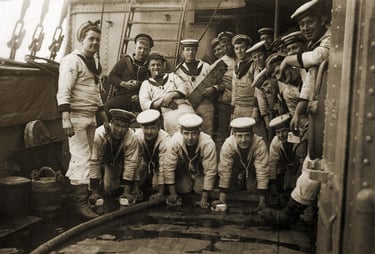Cleaning the Prison
11/2/20241 min read


Sailors holystoning the deck of HMS Pandora in the 20th century
On a well-managed convict transport, the prisoners would take their beds on deck in the morning when they went up for exercise, and strap them to netting along the ship’s side, so they could be aired. Although the benefit of this was not understood at the time, it would have reduced the spread of body lice which carried typhus.
With the convicts out of the way, their quarters could be scrubbed and fumigated by men working under one of the convict supervisors. If they were thorough, the bottom boards of the bunks would be lifted and swept underneath, but the construction of the berths meant this was not always possible. The prison would only be washed on clear days, when the scuttles could be opened and the windsails used to dry the deck. Hanging stoves and heated sand were also employed for this purpose. On other days, the floor would be scrubbed with a sandstone block known as a holystone.
The toilet tubs would be taken on deck each morning to be emptied, and then scrubbed with an old broom and refreshed using a solution of vitriol (sulphuric acid) and in later years, chloride of zinc or lime. Once water closets were introduced, some of the men would be assigned the task of scrubbing them out and keeping the cisterns filled with sea water.
Cleaning was followed by fumigation, to purify damp and foul air, which it was thought assisted in the spread of disease. Gunpowder and tobacco were burned on the First Fleet ships, and from 1796, brimstone, nitre and gunpowder devils mixed with vinegar. Warm vinegar would then be sprinkled between decks and the timbers liberally painted with ‘that excellent antiseptic’, oil of tar.
Contact us
Connect with us
Botany Baymen acknowledges the traditional custodians of country throughout Australia and respects their connection to land, water and community.
© Botany Baymen 2024. All rights reserved.
You may download, display, print and reproduce this content for your personal or non-commercial use but only in an unaltered form and with the copyright acknowledged.

